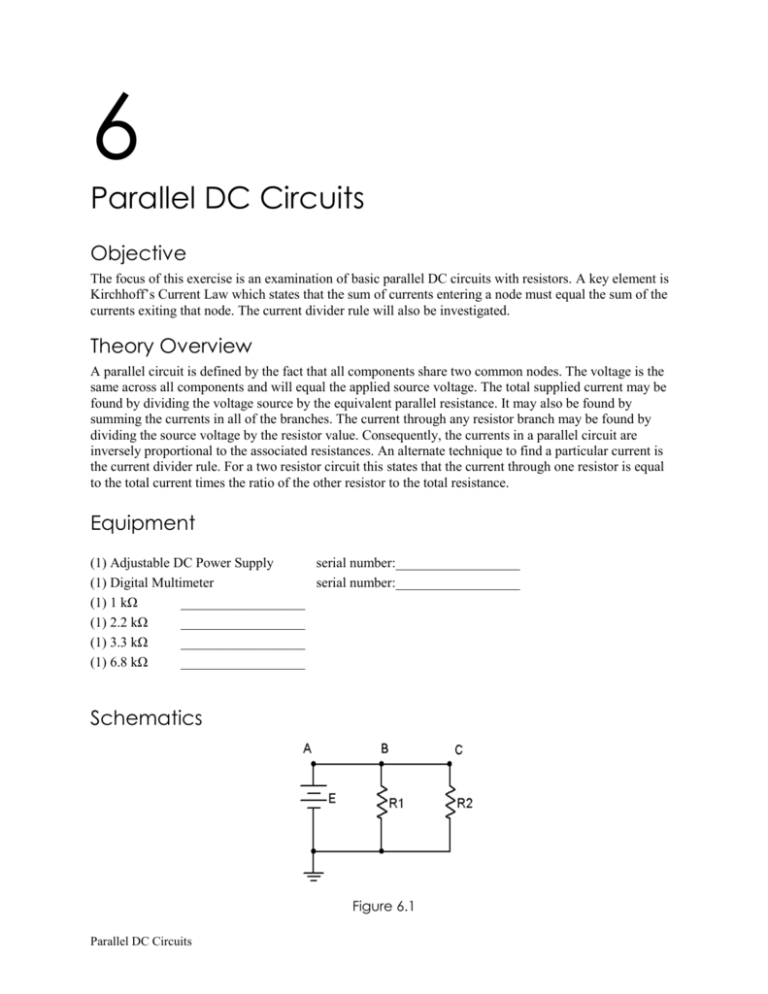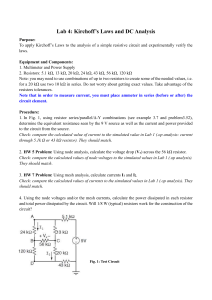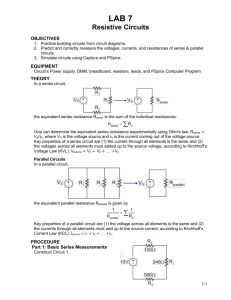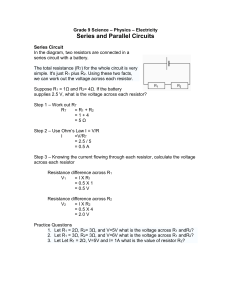6 Parallel DC Circuits
advertisement

6 Parallel DC Circuits Objective The focus of this exercise is an examination of basic parallel DC circuits with resistors. A key element is Kirchhoff’s Current Law which states that the sum of currents entering a node must equal the sum of the currents exiting that node. The current divider rule will also be investigated. Theory Overview A parallel circuit is defined by the fact that all components share two common nodes. The voltage is the same across all components and will equal the applied source voltage. The total supplied current may be found by dividing the voltage source by the equivalent parallel resistance. It may also be found by summing the currents in all of the branches. The current through any resistor branch may be found by dividing the source voltage by the resistor value. Consequently, the currents in a parallel circuit are inversely proportional to the associated resistances. An alternate technique to find a particular current is the current divider rule. For a two resistor circuit this states that the current through one resistor is equal to the total current times the ratio of the other resistor to the total resistance. Equipment (1) Adjustable DC Power Supply serial number:__________________ (1) Digital Multimeter serial number:__________________ (1) 1 kΩ __________________ (1) 2.2 kΩ __________________ (1) 3.3 kΩ __________________ (1) 6.8 kΩ __________________ Schematics Figure 6.1 Parallel DC Circuits Figure 6.2 Procedure 1. Using the circuit of Figure 6.1 with R1 = 1 k, R2 = 2.2 k and E = 8 volts, determine the theoretical voltages at points A, B, and C with respect to ground. Record these values in Table 6.1. Construct the circuit. Set the DMM to read DC voltage and apply it to the circuit from point A to ground. The red lead should be placed at point A and the black lead should be connected to ground. Record this voltage in Table 6.1. Repeat the measurements at points B and C. 2. Apply Ohm’s law to determine the expected currents through R1 and R2. Record these values in the Theory column of Table 6.2. Also determine and record the total current. 3. Set the DMM to measure DC current. Remember, current is measured at a single point and requires the meter to be inserted in-line. To measure the total supplied current place the DMM between points A and B. The red lead should be placed closer to the positive source terminal. Record this value in Table 6.2. Repeat this process for the currents through R1 and R2. Determine the percent deviation between theoretical and measured for each of the currents and record these in the final column of Table 6.2. 4. Crosscheck the theoretical results by computing the two resistor currents through the current divider rule. Record these in Table 6.3. 5. Consider the circuit of Figure 6.2 with R1 = 1 k, R2 = 2.2 k, R3 = 3.3 k, R4 = 6.8 k and E = 10 volts. Using the Ohm’s law, determine the currents through each of the four resistors and record the values in Table 6.4 under the Theory column. Note that the larger the resistor, the smaller the current should be. Also determine and record the total supplied current and the current IX. Note that this current should equal the sum of the currents through R3 and R4. 6. Construct the circuit of Figure 6.2 with R1 = 1 k, R2 = 2.2 k, R3 = 3.3 k, R4 = 6.8 k and E = 10 volts. Set the DMM to measure DC current. Place the DMM probes in-line with R1 and measure its current. Record this value in Table 6.4. Also determine the deviation. Repeat this process for the remaining three resistors. Also measure the total current supplied by the source by inserting the ammeter between points A and B. Exercise 6 7. To find IX, insert the ammeter at point X with the black probe closer to R3. Record this value in Table 6.4 with deviation. Data Tables Voltage Theory Measured VA VB VC Table 6.1 Current Theory Measured R1 R2 Total Table 6.2 Current CDR Theory R1 R2 Total Table 6.3 Parallel DC Circuits Deviation Current Theory Measured Deviation R1 R2 R3 R4 Total IX Table 6.4 Questions 1. For the circuit of Figure 6.1, what is the expected current entering the negative terminal of the source? 2. For the circuit of Figure 6.2, what is the expected current between points B and C? 3. In Figure 6.2, R4 is approximately twice the size of R3 and about three times the size of R2. Would the currents exhibit the same ratios? Why/why not? 4. If a fifth resistor of 10 kΩ was added to the right of R4 in Figure 6.2, how would this alter ITotal and IX? Show work. 5. Is KCL satisfied in Tables 6.2 and 6.4? Exercise 6











